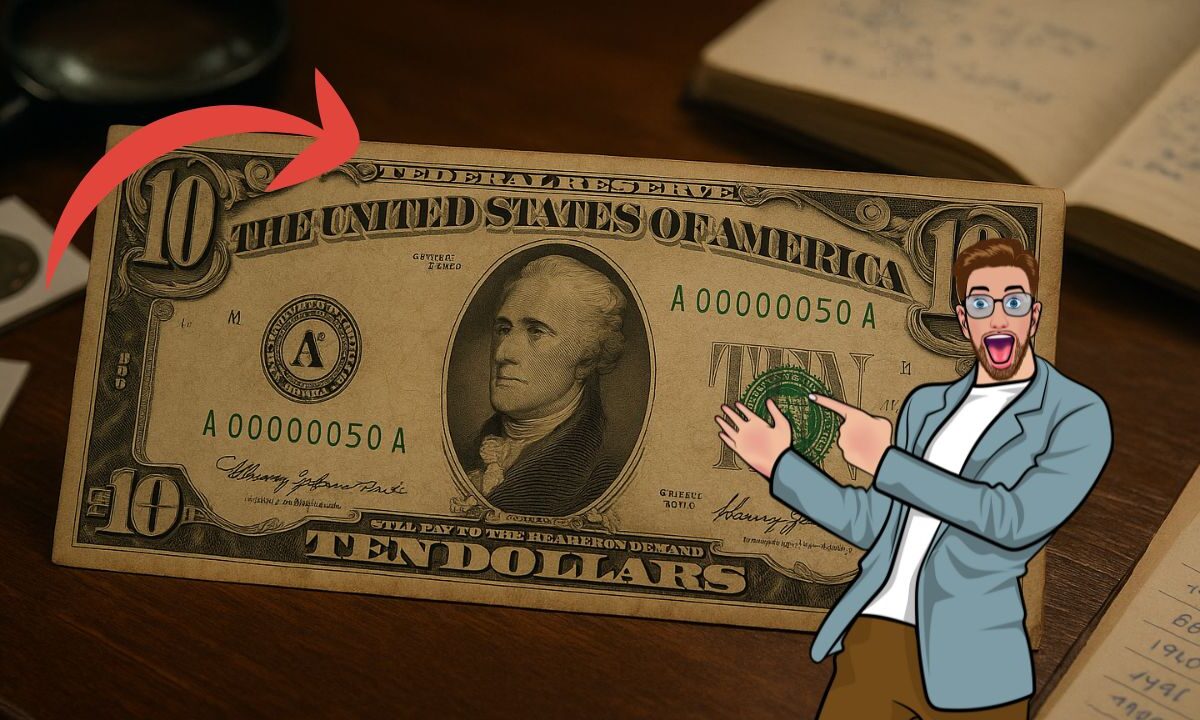The world of currency collecting is buzzing once again, and this time it’s all about a $10 bill that could be worth a staggering $3 million. Known for its rarity and unique characteristics, this banknote has caught the attention of collectors, investors, and history enthusiasts alike.
In this article, we’ll explore everything you need to know about this extraordinary note, why it’s so valuable, how to spot one, and the record-breaking sales shaking up the collector community.
The Fascination with Rare Currency
Collectors have always been captivated by rare currency, and the $10 bill worth millions is no exception. The intrigue comes from a combination of scarcity, historical significance, printing errors, and condition.
Unlike standard bills in circulation, these notes have survived decades, often in pristine condition, making them almost museum-worthy.
The U.S. Treasury has issued numerous series of $10 bills, but only a handful of them have become legendary in the collector market. Among these, certain bills from the 1928, 1934, and 1945 series have become particularly prized due to their limited prints and unusual serial numbers.
Why This $10 Bill is Worth $3 Million
Several factors contribute to the astronomical value of this bill:
- Rarity: Only a few of these notes exist in private collections.
- Condition: Many surviving examples are in near-perfect, uncirculated condition.
- Printing Error or Unique Features: Some bills have unique serial numbers, misprints, or overprints that make them more desirable.
- Historical Significance: Certain notes are associated with key events in American history, adding to their collectible value.
A notable example of this is the 1928 $10 Federal Reserve Note, which has a unique star serial number and excellent preservation, driving its market value into the millions.
How to Identify a High-Value $10 Bill
Identifying a $10 bill with the potential to fetch millions is not always straightforward. Here are the key indicators collectors look for:
| Feature | What to Look For | Why It Matters |
|---|---|---|
| Serial Number | Low serial numbers (00000001–00000100) or unique patterns (ladder, repeater, radar) | Extremely rare, boosts value significantly |
| Series & Year | 1928, 1934, 1945 $10 bills are highly sought | Older bills are more collectible due to scarcity |
| Printing Errors | Misaligned printing, missing elements, or double printing | Error notes are rare and highly valuable |
| Condition | Uncirculated, crisp bills with no folds or tears | Condition directly affects auction value |
| Star Notes | Notes with a star at the end of the serial number | Denotes replacement notes, often rare |
Collectors often pay tens of thousands just for the chance to own a bill with any of these characteristics. Combine all these factors, and it’s easy to see how a $10 bill could fetch $3 million or more.
Recent Auction Sales
Recent sales have highlighted just how competitive the market for rare $10 bills has become. At major auction houses, rare bills are routinely sold for prices that far exceed their face value.
For instance:
| Auction | Date | Bill Type | Sale Price |
|---|---|---|---|
| Heritage Auctions | 2024 | 1928 $10 Star Note | $2,950,000 |
| Stack’s Bowers | 2023 | 1934 $10 Federal Reserve | $1,850,000 |
| Sotheby’s | 2022 | 1945 $10 Silver Certificate | $1,200,000 |
These sales not only demonstrate the high value of rare $10 bills but also spark frenzied bidding wars among collectors, often resulting in record-breaking prices.
How to Verify Your $10 Bill
Before you dream of hitting a $3 million jackpot, it’s crucial to verify whether your bill has any collectible value. Here’s a step-by-step approach:
- Examine Serial Numbers: Look for low numbers or patterns such as repeating digits.
- Check the Series: Older bills are typically more valuable.
- Inspect for Errors: Look for misprints, misalignments, or unusual markings.
- Assess Condition: Even minor folds or stains can significantly reduce value.
- Professional Grading: Consider sending your bill to PCGS Currency or PMG for grading. High grades dramatically increase sale prices.
Tips for Collectors
Owning a rare $10 bill requires more than luck; collectors should follow best practices to protect their investment:
- Store Properly: Use acid-free sleeves and avoid direct sunlight.
- Keep Records: Document purchase, provenance, and any certifications.
- Avoid Circulation: Even light folding or handling can decrease value.
- Stay Informed: Join collector forums and subscribe to numismatic news to keep up with market trends.
- Insurance: High-value bills should be insured separately due to their enormous market value.
Why Collecting Rare Bills is Lucrative
Collecting currency isn’t just a hobby; it’s also a serious investment. Rare bills, especially those like the $3 million $10 note, can appreciate over time due to their scarcity and demand. Historical trends indicate that the value of top-tier currency has increased by 7–12% annually over the past decade.
Collectors also benefit from the emotional and historical connection. Each bill tells a story about the era it was printed, the treasury that issued it, and the economy of its time. This historical narrative enhances its intrinsic value.
How to Buy and Sell Rare $10 Bills
For those looking to enter the market, here’s how to navigate buying and selling:
- Auction Houses: Heritage Auctions, Stack’s Bowers, and Sotheby’s handle high-value bills.
- Private Sales: Often arranged through trusted numismatic dealers or brokers.
- Online Platforms: eBay and specialized currency marketplaces can also be viable for lower-tier rare bills.
When selling, consider grading, authenticity, and market timing. Auction results often dictate value, and rare notes can fetch more if marketed correctly to the right audience.
The $3 Million Buzz
The $3 million valuation has reignited collector interest and media coverage, sparking what is being called a collector frenzy. Even bills valued in the hundreds of thousands are now being scrutinized by collectors for unique features that could potentially push their value higher.
Experts predict that this trend will continue as interest in historical U.S. currency grows, and as more high-value bills surface from private collections.
Key Takeaways
- Rare $10 bills, particularly from the 1928–1945 series, can fetch millions due to scarcity, condition, and unique features.
- Serial numbers, star notes, and printing errors significantly enhance value.
- Verification, professional grading, and proper storage are essential for preserving value.
- Auction trends suggest that rare currency is not just a hobby but a lucrative investment opportunity.
The $3 million $10 bill is a shining example of how history, rarity, and collector demand intersect to create astronomical value in the world of numismatics.
Whether you’re a seasoned collector, a history enthusiast, or someone who just discovered an old bill in your wallet, understanding its value is the first step toward joining this exciting collector frenzy.
Proper identification, professional grading, and careful preservation are key to turning a simple piece of currency into a prized investment. Could you be holding a future millionaire in your pocket?
FAQs
Can any $10 bill be worth millions?
Not all $10 bills are valuable. Only bills with unique serial numbers, errors, star notes, or historical significance can fetch high prices.
How do I know if my $10 bill is genuine and valuable?
Examine serial numbers, series, printing errors, and overall condition. For confirmation, consider professional grading by PCGS Currency or PMG.
Is it safe to store a $3 million bill at home?
High-value bills should be stored in acid-free sleeves, away from sunlight, and preferably in a safe or bank safety deposit box. Insurance is also recommended.

